Canopus, Alpha Carinae (α Car), is a white bright giant star located in the southern constellation Carina. With an apparent magnitude of -0.74, it is the brightest star in Carina and the second brightest star in the sky, after Sirius. Canopus lies at an approximate distance of 310 light years from Earth. With an absolute magnitude of -5.71, it is the most luminous star within several hundred light years of the Sun.
Even though it is one of the brightest stars in the sky, Canopus is largely invisible to observers in the northern hemisphere. Because of its location in the far southern sky, the bright star never rises from locations north of the latitude 37° N.
Star type
Canopus is a bright giant star of the spectral type A9 II. Some astronomers give it the spectral class F0, even though the spectral type was changed to A9 after considering the effects of rotation in the late 1980s. In either case, Alpha Carinae appears white in colour. Some sources have described it as yellow-white, but this may be due to the star’s low position in the sky, where its colour is affected by atmospheric effects.
Canopus has a mass of 9.26 – 9.81 solar masses, which makes the evolved star a supernova candidate. As it left the main sequence, the star expanded to a size of 73.3 solar radii. If it were placed at the center of the solar system, it would come close to the orbit of Mercury (66 – 100 solar radii).
With a surface temperature of 7,400 kelvin, Canopus has a luminosity 16,600 times that of the Sun. The star is a relatively slow spinner. With a projected rotational velocity of 9 km/s, it takes over 298 days to complete a rotation.
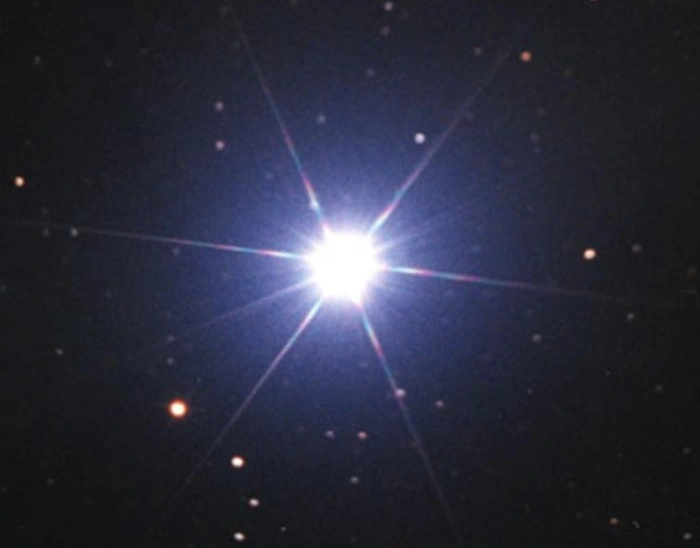
Canopus (Alpha Carinae), image credit: ESO/Digitized Sky Survey 2 (CC BY 4.0)
Canopus has run out of hydrogen to burn in its core and, after spending about 30 million years as a blue main sequence star with about 10 solar masses, it has evolved away from the main sequence and lost some of its initial mass.
The star has an estimated age of 33 – 34 million years. Even though it is a very young star, taking its mass into account, its entire lifespan will be measured in only tens of millions of years.
Canopus has already passed through the red giant branch (RGB) and has ceased burning helium in its core. Now it is in the blue loop phase of its life cycle, where it becomes a hotter star before it starts to cool again. The star may not be massive enough to end its life as a supernova. If it is not massive enough to fuse neon and its core does not collapse, it may leave a remnant neon-oxygen white dwarf.
Canopus was previously believed to be slightly less massive. The giant’s currently accepted parameters were derived in a 2021 study led by A. Domiciano de Souza of the Côte d’Azur Observatory, Lagrange Laboratory, Côte d’Azur University in Nice, France. The team of astronomers refined the star’s parameters based on near-infrared interferometry with the PIONIER and AMBER instruments on the Very Large Telescope Interferometer (VLTI) and an analysis of the star’s spectral energy distribution (SED).
They obtained the most precise measurement of the star’s angular diameter to date – 7.184 ± 0.0017 ± 0.029 – and used it to determine its several fundamental parameters, including temperature, luminosity, mass, radius, gravity, and age. Their findings were published in Astronomy & Astrophysics.
The currently accepted distance of 310 light years is based on the 2007 Hipparcos reduction and a parallax of 10.43 ± 0.53 milliarcseconds. Before the launch of the Hipparcos satellite, distance estimates ranged from only 96 light years to as much as 1,200 light years.
Canopus exhibits small changes in radial velocity believed to be caused by movements in its atmosphere. The star has a magnetic field that shows variations with the same period (6.90 days). Its magnetically heated corona is about 10 times hotter than the Sun’s and emits radio waves and X-rays. Similar emissions have been detected in other supergiants, including the bright Mirfak (Alpha Persei) in the constellation Perseus, and are considered a common characteristic of such stars.
Canopus may have a red dwarf companion. In 2014, American astronomer Eric Mamajek reported a possible common motion companion located 1.16 degrees south of Canopus. The red dwarf shows strong magnetic activity and appears to be moving through space with Canopus.
Even though the projected separation between the two stars is quite large – about 1.9 parsecs – it still puts the red dwarf within the estimated tidal radius of Canopus (2.9 parsecs) if the stars lie at the same distance from Earth. The dwarf has the designation 2MASS J06234738-5351131 in the Two Micron All Sky Survey (2MASS) catalogue and is sometimes referred to as Canopus B.
Facts
Canopus is an important star in the field of celestial navigation. Navigational stars are among the brightest and most recognizable stars in the night sky, which makes them exceptionally useful in navigation.
Canopus and two other Carina stars – the fainter Miaplacidus and Avior – belong to the southernmost group of navigational stars, with a declination between 30° S and 90° S. Other stars in this group include Suhail in the constellation Vela, Ankaa in Phoenix, Alpha Centauri, Hadar and Menkent in Centaurus, Achernar and Acamar in Eridanus, Acrux and Gacrux in Crux, Fomalhaut in Piscis Austrinus, Kaus Australis in Sagittarius, Shaula in Scorpius, and Peacock in Pavo.
Canopus was the brightest star of the Greek constellation Argo Navis, which represented the great ship on which Jason and the Argonauts sailed on their quest to get the Golden Fleece. The constellation was split into three smaller ones – Carina, Puppis and Vela, representing the keel, stern (poop deck) and sails of the ship – by the French astronomer Nicolas Louis de Lacaille in the 18th century. As the luminary of Argo Navis, Canopus had the designation Alpha Argus Navis (α Arg), which was later changed to Alpha Carinae.
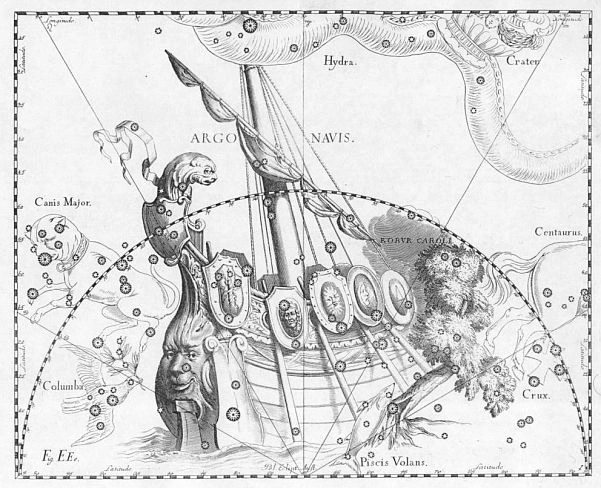
The constellation of Argo Navis from Firmamentum Sobiescianum, sive Uranographia by Johannes Hevelius. The view is mirrored following the tradition of celestial globes, showing the celestial sphere in a view from “outside.”
Canopus is one of the 27 bright stars featured on the national flag of Brazil. Each star on the flag represents a Brazilian Federative Unit and Canopus symbolizes the state of Goiás.
Canopus is invisible from most northern locations. It never rises above the horizon for observers north of the latitude 37° 18’ N. European observers became familiar with the star, as well as with its bright southern neighbours Alpha Centauri and Achernar, through the work of the English geographer and explorer Robert Hues. Hues described the three southern first-magnitude stars in his Tractatus de Globis (1592).
Due to the Earth’s axial precession, Canopus will come within 10 degrees of the south celestial pole around the year 14,000 CE.
With an absolute magnitude of -5.71, Canopus is more luminous than any other star that is closer to Earth. Even though it is currently the 2nd-brightest star in the sky, it is much more luminous than Sirius. With a luminosity 25.4 times that of the Sun and an absolute magnitude of +1.42, Sirius appears brighter mainly because it is one of our nearest neighbours, lying at a distance of only 8.60 light years.
Canopus was the brightest star in the sky several times in the last few million years and will be the brightest star again in 480,000 years. It replaced Mirzam (Beta Canis Majoris) as the brightest star 3,700,000 years ago, peaking at magnitude -1.86, and held the title until 1,370,000 years ago, when it was outshone by Ascella (Zeta Sagittarii).
Then, 950,000 years ago, it once again became the brightest star, dethroning Zeta Leporis and peaking at magnitude -1.09, and held the title until it was succeeded by Aldebaran (Alpha Tauri) 420,000 years ago.
About 160,000 years ago, it took the title again, this time from Capella (Alpha Aurigae), and stayed the brightest star until it was replaced by Sirius some 90,000 years ago. At its brightest, Canopus shone at magnitude -0.70.
Sirius will stay the brightest star in the Earth’s sky for another 210,000 years. It will be succeeded by Vega (Alpha Lyrae). Vega will be replaced by Canopus again in about 480,000 years. Canopus will shine at magnitude -0.40 at its brightest and keep the title until it is outshone by Menkalinan (Beta Aurigae) in 990,000 years.
Without interstellar extinction, Canopus would be 0.26 magnitudes brighter. It would still not outshine Sirius.
Canopus was listed as a standard star for the spectral class F0 in the Henry Draper Catalogue (HD), published between 1918 and 1924. It was considered an F-class star for about a century. It was assigned this class in 1897 as a star with relatively weak hydrogen lines and a strong calcium K line.
In 1942, American astronomer Jesse Greenstein reported that the spectrum of Canopus was dominated by strong broad lines of hydrogen after observing the star with the 82-inch Otto Struve Telescope at McDonald Observatory on Mount Locke in West Texas.
In 1966, observations in the ultraviolet confirmed that the star’s spectrum was consistent with a class F0 supergiant with an effective temperature of 6,900 K. A more detailed study of the star’s spectrum, published in 1982, gave an effective temperature of 7,350 ± 30 K.
When luminosity classes were introduced to the Morgan-Keenan (MK) classification scheme, Canopus was given the class Iab (intermediate luminosity supergiant). In 1991, it was assigned the spectral class F0II, indicating a bright giant and not supergiant, in the 5th edition of the Bright Star Catalogue.
In the late 1980s, a study that took into account the effects of rotation on spectral classification adjusted the spectral class of Canopus to A9II.
The angular diameter of Canopus was measured interferometrically in 1968, yielding a value of 6.86 milliarcseconds (mas) for the limb-darkened diameter. A diameter of 6.9 mas was obtained using AMBER (Astronomical Multi-BEam combineR), the near-infrared spectro-interferometric instrument of the Very Large Telescope Interferometer (VLTI), in 2013. A physical radius of 71 ± 4 solar radii was derived from the angular diameter of 6.92 mas and the star’s distance.
The currently accepted diameter of 7.184 ± 0.0017 ± 0.029 mas corresponds to a physical radius of 73.3 ± 5.2 solar radii.
Canopus was once believed to be a member of the Scorpius-Centaurus Association (Sco-Cen, Sco OB2), the nearest OB association to the solar system. The stellar grouping includes Antares, Acrux, Mimosa, Imai, and other stars in the constellations Scorpius, Centaurus, Crux, and Lupus. However, Canopus does not lie near any of the subgroups of Sco OB2. It is currently believed not to belong to this or any other nearby stellar group.
Canopus has been known to observers in southern latitudes since ancient times. While it was invisible to most cultures north of the equator, it could be seen from Mesopotamia, Egypt, India, and China. It did not rise above the horizon for ancient Greeks and Romans, but the Greek astronomers Eratosthenes and Ptolemy, who lived in the city of Alexandria in Egypt, were both familiar with the star and called it Kanōbos.
In ancient Mesopotamia, Canopus was called NUN-ki. It symbolised the ancient city of Eridu in Babylonian star catalogues and in the astronomical compendium MUL.APIN (c. 1100 BCE). Today, the name Nunki belongs to Sigma Sagittarii, the second brightest star in the constellation Sagittarius.
In China, Canopus was known as Shou Xing, or the Star of Longevity. The name was mentioned in the Shiji (Records of the Grand Historian), a history of ancient China and one of the foundational texts of the Chinese civilization. The text was finished by the Chinese historian Sima Qian around the year 94 BCE.
Sima Qian considered Canopus to be Sirius’ southern counterpart. The star was mentioned in a sanctuary dedicated to it, established by the Chinese emperor Qin Shi Huang, the founder of the Qin dynasty, between 221 and 210 BCE. In the Middle Ages, Canopus was commonly known as the Old Man of the South Pole in China.
In India, Canopus is known as Agastya. The star’s traditional name comes from Agastya, a Vedic rishi (sage) who authored hymns in Rigveda and other Vedic literature.
The major axis of the Kaaba, a building at the centre of the Great Mosque of Mecca, is aligned with the rising of Canopus, and its southeast wall is directed toward the star.
The Negev Bedouin of Israel called the star Suhayl. Canopus and Polaris were the most important stars the Bedouin used in navigation.
The Guanche people of the island of Tenerife associated Canopus with Chaxiraxi, the Sun Mother and one of the principal deities in the Guanche pantheon.
In Botswana, the Nyae Nyae ǃKung people of the Kalahari Desert saw Canopus and Capella as the horns of Tshxum (the Pleiades). Canopus was the male horn and Capella the female one. The appearance of the two stars and the cluster in the sky signalled the beginning of the rainy season.
The Sotho people of southern Africa know Canopus as Naka, the Horn Star, and traditionally keep watch for it in late May, awarding a cow for the earliest sighting.
The Tswana people would watch for Canopus and start breeding their sheep when the star appeared in the sky before sunrise. The Venda people call the star Nanga, also meaning the Horn Star, and its first sighting in the morning sky is also awarded with a cow.
The Zulu knew the star as isAndulela, a messenger appearing in late fall at harvest time. They also called it inKhwenkwezi, meaning “brilliant star.” The /Xam Bushmen knew Canopus as the “digging stick” and the “ant egg star.” They believed that the star could affect the availability of ants’ eggs.
Canopus and Sirius announced the appearance of flying ants and termites. The Bushmen prayed to the two stars, believing that they could bring misfortune. The Xhosa-speaking people called Canopus U-Canzi-be and associated it with harvest.
The Navajo in the American Southwest called Canopus Maʼii Bizòʼ, the Coyote Star. In Navajo legends, Ma’ii (Coyote) placed the star in the southern sky and named it after himself. The star was also sometimes known as So dondizidi (the No-Month Star).
In Brazil, the Kalapalo people of the state of Mato Grosso saw Canopus as part of an asterism known as Duck. Canopus and Procyon were known as Kofongo (“Duck”) and the Gemini stars Pollux and Castor marked the hands of Duck. The appearance of the hands on the southwestern horizon signalled the coming of the rainy season and an abundance of manioc, a local food staple.
In Hawaii, Canopus was known as Ke Alii-o-kona-i-ka-lewa, meaning “the chief of the southern expanse.” In local lore, it was one of the stars used by Hawai’iloa to navigate when travelling to the Southern Ocean. (In Hawaiian legend, Hawai’iloa was a fisherman who stumbled upon the island of Hawai’i and later returned to settle it.)
Ancient Polynesians also used Canopus and other bright stars to navigate between the islands of the Pacific. Canopus was part of a Great Bird constellation, known as Manu, which divided the sky into two hemispheres. Canopus marked the Great Bird’s southern wingtip. Procyon in Canis Minor was the northern wingtip, and the bright Sirius represented the bird’s body.
In Australia, Canopus had a prominent role in several indigenous cultures. The Boorong people of northwest Victoria called the star War. War, a male crow, was the husband of Collowgullouric War, a female crow, likely represented by Eta Carinae, and brother of Warepil, an eagle, represented by Sirius. In local lore, War was a Prometheus-like figure who brought fire to humankind.
The Koori people of southeast Australia also associated Canopus with a crow. The star represented Waa, one of the moiety ancestors. The crow is often a trickster and an ancestral figure in Australian Aboriginal mythology. The other ancestral being is Bunjil, the eaglehawk, represented by Altair in Aquila.
In the legends told by the Pirt-Kopan-noot people of western Victoria, Waa fell in love with a queen, Gneeanggar (“wedge-tailed eagle”), represented by Sirius, and her six attendants, represented by the Pleiades. After being rejected by them, Waa turned himself into a grub after hearing that the women were foraging for grubs and, when one of them dug him out, he transformed into a giant and carried her off.
The Wailwun of New South Wales called Canopus Wumba, meaning “deaf.” In Tasmanian lore, the star was associated with Dromerdene, who fought with his brother Moinee until they both fell from the sky. Moinee is an ancestral figure who created the first human being. Dromerdene changed the human’s anatomy, which upset Moinee, and the brothers fought against each other in the heavens. After the fight, Dromerdene is said to have fallen into Louisa Bay and Moinee fell to earth. A large standing stone behind Cox Bight beach in southwest Tasmania is said to be his petrified form.
The Māori people of New Zealand saw Canopus as a solitary star and called it Atutahi, Atuatahi or Aotahi, meaning “stand alone.” They also called it Ariki, meaning “high-born.” The star’s appearance at the winter solstice heralded the coming of winter and the Māori offered food to the star when it appeared. They believed that its light rays foretold the coming winter and whether it would be mild or cold and wet.
In the Society Islands, Canopus was known as Taurua-e-tupu-tai-nanu, meaning “Festivity-whence-comes-the-flux-of-the-sea,” and Taurua-nui-o-te-hiti-apatoa, “Great-festivity-of-the-border-of-the-south.” In the Tuamotu Islands, the star was called Te Tau-rari and Marere-te-tavahi, meaning “he-who-stands-alone.”
The 12th century CE Andalusian astronomer and polymath Ibn Rushd observed Canopus from Marrakesh in 1153. As the star is invisible from his native city of Córdoba, Spain, he used this observation to argue in favour of Aristotle’s claim that the Earth was spherical.
Like other exceptionally bright stars, Canopus has often been used or referenced in works of fiction. In Dante’s Purgatory, it was one of the “three torches” (“tre facelle”) that symbolized three evangelical virtues – faith, hope and charity – along with the fellow southern luminaries Fomalhaut and Achernar.
Other notable mentions include the science fiction novels The Star Kings (1947) by Edmond Hamilton, Star Bridge (1955) by James Gunn and Jack Williamson, Alfred Bester’s The Stars My Destination (1956), Frank Herbert’s Dune novels (in which it is the host star of the desert planet Arrakis), and Doris Lessing’s Canopus in Argos series.
In film and television, the star was notably used in the episodes “Where No Man Has Gone Before” (1966) and “The Ultimate Computer” (1968) of Star Trek: The Original Series, and in the episode “The Kidnappers” (1967) of the television series The Time Tunnel. Canopus is also used in the BattleTech, Frontier: Elite II, and Frontier: First Encounters games.
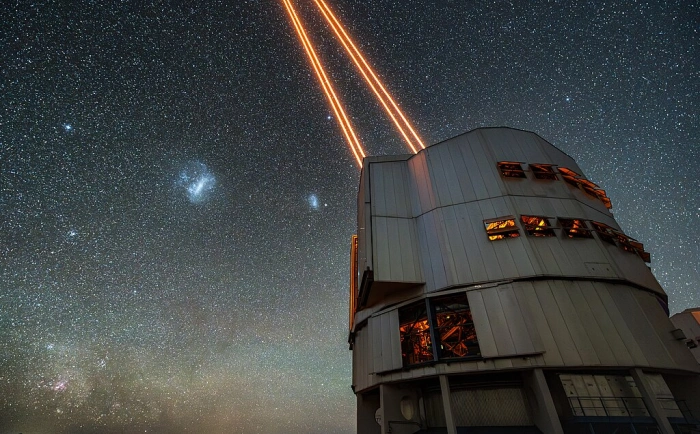
The night sky is full of stars, but there are other astronomical objects visible in this picture taken at Paranal Observatory. The pinkish nebula at the very bottom on the left is the Carina Nebula. Further up, there is a bluish bright star: it is Canopus, the second-brightest star in the night sky. Over to the right of Canopus, the two bluish clouds of the Large and Small Magellanic Clouds, two irregular neighbouring galaxies of the Milky Way, can be seen. To observe these and other celestial objects in greater detail, the biggest barrier for ground-based telescopes is the turbulence of Earth’s atmosphere, which makes astronomical images blurry. But the ESO’s Very Large Telescope’s (VLT) adaptive-optics system can solve this issue, and the lasers of the Laser Guide Stars Facility installed on the VLT’s Unit Telescope 4 play a key role. These lasers excite the sodium atoms in the atmosphere, which in turn emit light that is affected by the irregular air motions in the same way as the light from stars. The light is collected by the telescope and can be used by the VLT’s adaptive-optics system to measure the distortions introduced by the atmosphere and then to correct for them. Image credit: ESO (CC BY 4.0)
Name
Canopus (pronunciation: /kəˈnoʊpəs/) has been the traditional name of Alpha Carinae since ancient times. It appeared in Claudius Ptolemy’s Almagest in the 2nd century CE. It has also been spelled Canobus, Kanopus and Kanobos.
The origin of the name is uncertain. It is generally believed that the name comes from the Greek Κάνωβος (Kanôbos), which was the name of the mythical navigator for Menelaus of Sparta during the Trojan War. In Greek mythology, after the destruction of Troy in 1183 BCE, Menelaus’ fleet stopped in Egypt on their way home to Greece, and Canopus was bitten by a snake. Menelaus erected a monument in his honour in the Nile Delta, where the town of Canopus later developed. In Homeric myths, it was Menelaus who founded the town and named it after his pilot.
The second possible derivation of the name is from the Egyptian Coptic Kahi Nub, meaning “Golden Earth.” This is a reference to the appearance of Canopus close to the horizon in ancient Egypt.
The name was approved by the International Astronomical Union’s (IAU) Working Group on Star Names (WGSN) on June 30, 2016. It formally applies only to the component Alpha Carinae A.
Canopus has been known by many other names across different cultures. In English, it was also known as Suhail, Soheil or Soheila, derived from the Arabic suhayl, meaning “smooth plain.” Different spellings included Süheyl/Süheyla (Turkish), Souhail, Suheyl, Sohil, Suhilon, Sahil, Sihil, and Suhayeel.
The star shared this name with Lambda Velorum, Gamma Velorum, and Zeta Puppis. Today, Zeta Puppis is formally named Naos, Gamma Velorum is informally known as Regor, and Lambda Velorum has kept the name Suhail.
A 15th century BCE Egyptian poet called Canopus Karbana and, during the Ptolemaic rule, the star was called Ptolemaion. The acronychal rising of Canopus (last rising in the evening after sunset after a period of visibility) marked the beginning of the Ptolemaia festival, held every four years from 279 BCE to 145 BCE.
The Greek poet Aratus (c. 310 – 240 BCE) and astronomers Eudoxus (c. 390 – 337 BCE) and Hipparchus (c. 190 – 120 BCE) called the star Pedalion, which is Greek for “the rudder.” The designation referred to the star’s position in Argo Navis, marking the rudder of the mythical ship. The Roman philosopher Cicero, who translated Aratus’ work into Latin, called the star Gubernaculum, which is Latin for “rudder” or “helm.”
Canopus was also known as Wazn, derived from the Arabic word for “weight,” and as Hadar, meaning “ground.” Today, the names Wazn and Hadar formally apply to Beta Columbae and Beta Centauri. The derivation Wezen belongs to Delta Canis Majoris.
The names Ponderosus (“heavy” or weighty”) and Terrestris (“terrestrial” or “earthly”) were also later used for Canopus. Both are believed to refer to the star being close to the horizon.
In the Alphonsine Tables, Canopus was designated as Suhel ponderosus, which is a Latinized form of the Arabic Al Suhayl al Wazn. The name Canopus came back into wide use during the Renaissance.
In China, Canopus is known as 老人 (Lǎo Rén), the Old Man. It is the sole star in the Old Man asterism, which is part of the Well mansion, one of the southern mansions of the Vermilion Bird.
In Chinese astronomy, Canopus was known as the Old Man of the South Pole (南极老人), a symbol of longevity and happiness. In Chinese lore, the Old Man is depicted as a man with a long white beard and a deer at his side, who was once a sickly boy who had been told that he would not live past the age of 19. The boy, named Zhao Yen, was advised to visit a field and bring wine and dried meat. He did as he was told and, when he reached the field, he found two men playing checkers. He offered them the wine and meat and, to thank him, the men changed his life expectancy from 19 to 91 years. The boy later learned that the men were the star of the North Pole and the star of the South Pole, responsible for fixing the dates of birth and passing.
Canopus is also known as the Star of Old Age in the neighbouring Korea, Japan and Vietnam. In Japan it is known as Jurōjin, the god of longevity and one of the Seven Gods of Fortune, who originated from the Chinese Taoist Old Man of the South Pole. The star’s other traditional names in Japan are Mera-boshi and Roujin-sei, or the Old Man Star.
In Mongolia, Canopus was the personification of the White Old Man, while Tibetans called it Genpo karpo (Rgan po dkar po) or Genkar (Rgan dkar), also meaning “white old man.” In Tibet, the more widely used name for Canopus was Karma Rishi. The star’s heliacal rising (the first rising after a period of invisibility) was celebrated with ritual bathing.
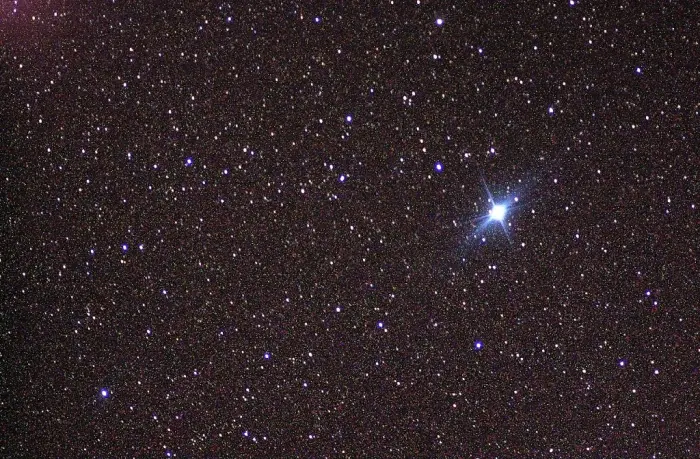
Canopus, image taken from the International Space Station (ISS), image: NASA (CC BY 4.0)
Location
Canopus lies in the far southern sky. At declination −52° 41′ 44.3810″, the star is invisible to most northern observers. It cannot be seen from locations north of the latitude 37° 18’ N, which means that it does not rise above the horizon for most of Europe, all of Canada, and a good portion of the continental United States.
For observers south of the latitude 37° 18’ S, Canopus is circumpolar, i.e. it never sets and is visible throughout the year. As an exceptionally bright star, Canopus is visible to the unaided eye in early twilight. It reaches its highest point above the horizon at midnight on December 27 and around 9 pm on February 11.
As the second brightest star in the sky, Canopus is very easy to identify. It is the bright star appearing below Sirius, almost exactly south of Sirius’ neighbour Mirzam (Beta Canis Majoris).
Sirius can be identified using the three stars of Orion’s Belt – Alnitak, Alnilam, and Mintaka – which point directly at it. Canopus and Sirius are separated by about 36 degrees on the sky and, while most northern observers can only see Sirius, from southern latitudes both stars can often be seen at the same time.
Canopus appears in the same area of the sky as the False Cross, a bright asterism often mistaken for the Southern Cross. The False Cross is formed by the Carina stars Avior and Aspidiske with the Vela stars Alsephina and Markeb. A line drawn from Aspidiske through Avior points in the general direction of Canopus.
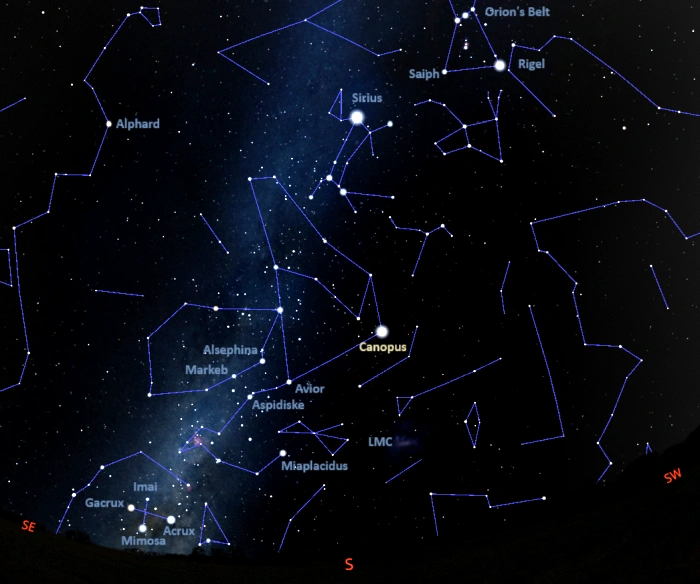
The location of Canopus (Alpha Carinae), image: Stellarium
Sirius and Canopus can be used to find the Large Magellanic Cloud (LMC). A line extended from Sirius through Canopus points towards the Milky Way’s satellite. The dwarf galaxy is one of the Milky Way’s nearest neighbors. It appears as a detached piece of the Milky Way’s bright band on a clear night.
Canopus can be used to find the south celestial pole. The pole forms an equilateral triangle with Canopus and Achernar, the brightest star in the constellation Eridanus. It lies roughly halfway between Achernar and Hadar, one of the Southern Pointers in Centaurus.
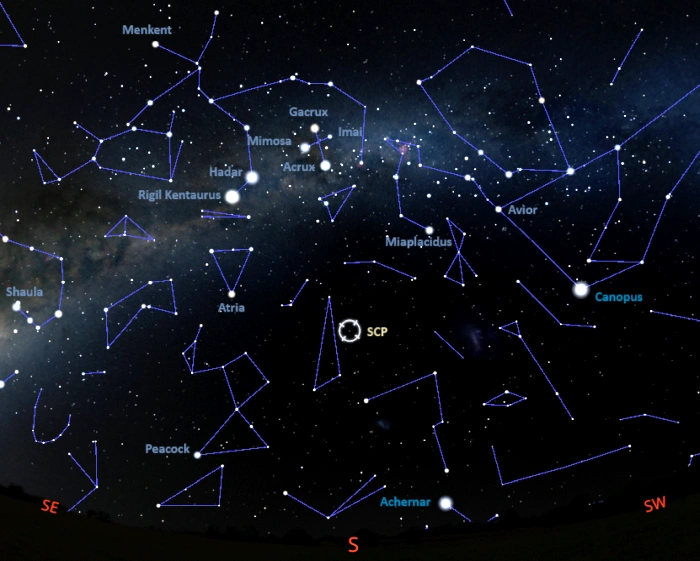
Achernar, Canopus and the south celestial pole, image: Stellarium
Constellation
Canopus is located in the constellation Carina. Formerly part of the larger Argo Navis constellation, Carina represents the keel of the ship Argo, on which Jason and the Argonauts sailed to Colchis to get the Golden Fleece. The neighbouring constellations Puppis and Vela, also split off from Argo Navis in the 18th century, represent the ship’s stern and sails.
With an area of 494 square degrees, Carina is not particularly large, but it is easily recognizable. It contains six stars brighter than magnitude 3.00. Some of them are part of two prominent southern asterisms, the Diamond Cross and the False Cross.
The constellation is known for being home to Canopus, the second brightest star in the sky, and Eta Carinae, one of the most massive binary star systems known. Eta Carinae is the central star of the Homunculus Nebula, which is part of the larger Carina Nebula (NGC 3372), a vast region of bright and dark nebulosity that contains several open clusters and some of the most luminous stars in the Milky Way galaxy.
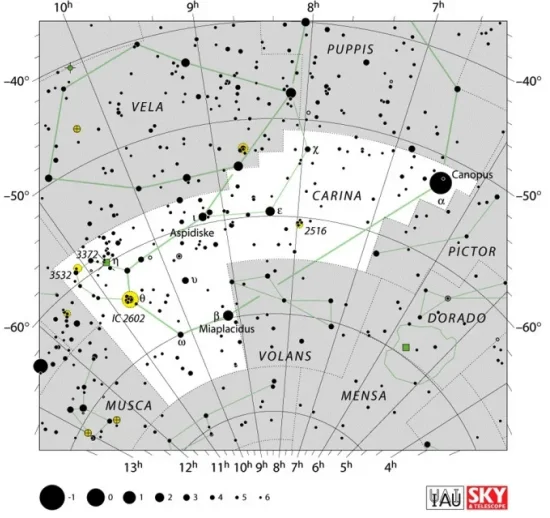
Carina constellation map by IAU and Sky&Telescope magazine (Roger Sinnott & Rick Fienberg) (CC BY 3.0)
Other notable stars of Carina include the white giant Miaplacidus (Beta Carinae), the orange giant Avior (Epsilon Carinae), the blue-white supergiants Aspidiske (Iota Carinae), Upsilon Carinae and V533 Carinae, the blue straggler Theta Carinae, the luminous blue variables AG Carinae and HR Carinae, the variable red supergiant RT Carinae, the massive triple star system HD 93129, the blue giant Omega Carinae, the Cepheid variable yellow supergiant l Carinae, the rare yellow hypergiant x Carinae (V382 Carinae), the pre-main sequence star Aiolos (HD 95086) with a confirmed exoplanet, and the Wolf-Rayet stars WR 22, WR 24 and WR 25, all three among the most massive and most luminous stars known.
In addition to the Carina Nebula, well-known deep sky objects in Carina include NGC 3603, a large H II region with an open cluster, the Statue of Liberty Nebula (NGC 3576), the Theta Carinae Cluster (IC 2602), a bright, large open cluster nicknamed the Southern Pleiades, the Wishing Well Cluster (NGC 3532), an open star cluster visible to the unaided eye, the Gem Cluster (NGC 3293), NGC 2802, a massive globular cluster, and the Diamond Cluster (NGC 2516), a bright open cluster nicknamed the Southern Beehive.
The best time of the year to observe the stars and deep sky objects in Carina is during the month of March, when the constellation is particularly prominent in the evening sky from southern locations. The entire constellation is visible from locations south of the latitude 20° N.
The 10 brightest stars in Carina are Canopus (Alpha Car, mag. -0.74), Miaplacidus (Beta Car, mag. 1.69), Avior (Epsilon Car, mag. 1.86), Aspidiske (Iota Car, mag. 2.21), Theta Carinae (mag. 2.76), Upsilon Carinae (2.97), Omega Carinae (mag. 3.29), PP Carinae (p Car, mag. 3.22 – 3.55), V337 Carinae (q Car, mag. 3.36 – 3.44), and V357 Carinae (a Car, mag. 3.41 – 3.44).
Canopus – Alpha Carinae
| Spectral class | A9 II |
| U-B colour index | +0.10 |
| B-V colour index | +0.15 |
| Apparent magnitude | -0.74 |
| Absolute magnitude | -5.71 |
| Distance | 310 ± 20 light years (95 ± 5 parsecs) |
| Parallax | 10.55 ± 0.56 mas |
| Radial velocity | 20.30 ± 0.5 km/s |
| Proper motion | RA: 19.93 ± 0.52 mas/yr |
| Dec.: 23.24 ± 0.69 mas/yr | |
| Mass | 9.26 – 9.81 ± 1.83 M☉ |
| Luminosity | 16,600 L☉ (15,920 – 17,300 L☉) |
| Radius | 73.3 ± 5.2 R☉ |
| Temperature | 7,400 K |
| Metallicity | -0.07 dex |
| Rotational velocity | 9 km/s |
| Rotation | ≥298 days |
| Surface gravity | 1.70 ± 0.05 cgs |
| Age | 33 – 34 million years |
| Constellation | Carina |
| Right ascension | 06h 23m 57.10988s |
| Declination | −52° 41′ 44.3810″ |
| Names and designations | Canopus, Suhail, Suhayl, Suhel, Alpha Carinae, α Carinae, α Car, HD 45348, HR 2326, HIP 30438, FK5 245, SAO 234480, GC 8302, GCRV 4091, CPD−52°1941, CPC 19 2125, JP11 1384, PLX 1497.00, PPM 335149, EUVE J0624-52.6, 2EUVE J0624-52.6, SKY# 10936, SRS 30245, GEN# +1.00045348, N30 1391, WEB 6060, 1E 0622.8-5239, 2E 1642, CEL 1228, TD1 7115, 1ES 0622-52.6, UBV 6431, UBV M 12094, ROT 1039, uvby98 100045348, IRAS 06228-5240, 2MASS J06235709-5241441, EXSS 0622.7-5240, 1AXG J062403-5241, 1RXS J062357.2-524139, TIC 255559489, TYC 8534-2277-1 |